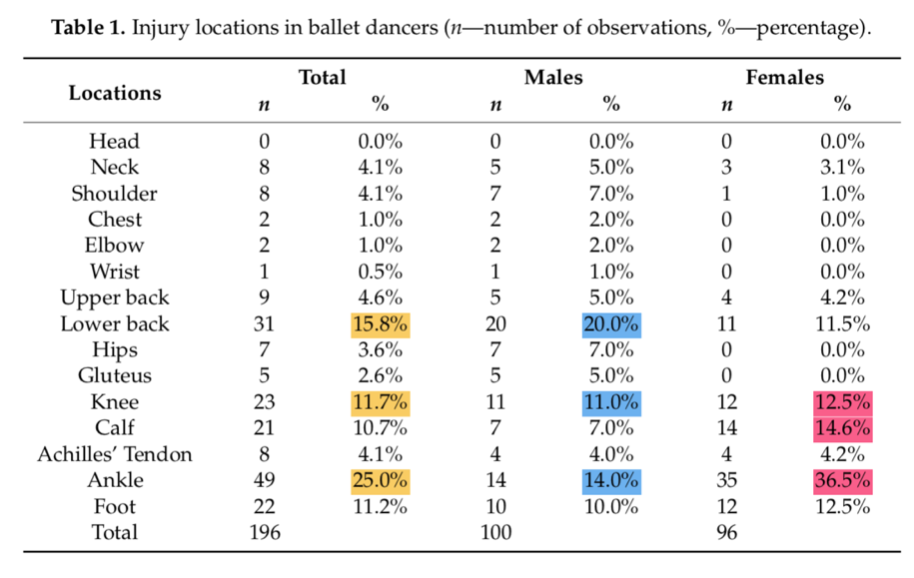
Professional Ballet: Injuries & Return to Dance
This article discusses injury occurrence in 99 professional ballet dancers. The article looks at several factors including age, education level, experience, ballet status, cigarette smoking, alcohol consumption and drug use and its effects on injury occurrence and time-off due to injury.
Part 1: Introduction
Part 2: Results
Part 3: Conclusion
Part 1: Introduction
Professional ballet dancers undergo a great deal of stress. This can be attributed to training demands, scheduling, employment and other extraneous factors (family or social life). Injuries are quite common in ballet and are often categorized into acute (traumatic, like an ankle sprain) or overuse (too much work too soon).
Training for a performance can consume up to 40 hours of rehearsing. The repetitive nature of the movements contribute to early wear and tear with progressive degeneration over time. Ankles were the most commonly injured body part whereas knee injuries resulted in the greatest time off from training. Studies demonstrate that on average, females take 3 days off and males take 9 days off. Functionally, several factors contribute to injuries in ballet dancers: poor movement control; weak abdominal muscles, lower body strength; and poor aerobic endurance.
Coping mechanisms for managing stress associated with being a professional dancer were lacking in the ballet community. More than two thirds of men state they binge-drank more than once per week and more than 30% of women smoked cigarettes.

The below table demonstrates that smokers sustained higher rates of injury and less experienced dancers were more likely to be absent from dance class compared to more experienced dancers.

Part 2: Results- What affects professional ballet dancers injury rate?
This study received responses from 99 professional ballet dancers (41 males, 58 females) in Croatia and Slovenia. The dancers engaged in an additional 25-30 dance hours per week, in addition to their rehearsals.
Forms were filled out to identify the dancers age, education level, experience and position within the ballet company and number of training hours per week of each dancer. Additional information was gathered on the use of cigarette smoking, alcohol drinking and drug use. Injury status was also obtained- including body part and number of days they took off from dance.
Table 1 demonstrates that the majority of injuries in male dancers occurred in the lower back (20%), ankle (14%) and knee (11%). Female dancers sustained the most from the ankle (36.5%), then the calf (14.6%) and the knee (12.5%).
Part 3: Conclusion
Smoking cigarettes and drinking alcohol negatively affected the rate of injury and the amount of time off due to injury in these professional ballet companies. Smoking increases chronic inflammation, causes vascular damage, increases oxidative stress and affects bone mineral content. This results in a higher injury risk and longer recovery times.
More experienced female dancers tend to take less time off due to injury. This may be attributed to a difference in perspective about what may constitute an “injury” and what may be likened to normal, dance-related “aches”.
Binge drinking alcohol negatively effects training recovery, disturbs sleep, and acts as an immunosuppressant. It also interferes with anabolic (muscle building) hormones and increases total system inflammation.
Injury rate and time-off due to injury are influenced by several factors, some of them modifiable. The modifiable factors include alcohol consumption, cigarette smoking and illicit drug use. It may be prudent for companies to invest in substance abuse education to improve the quality and longevity of professional ballet dancers careers.